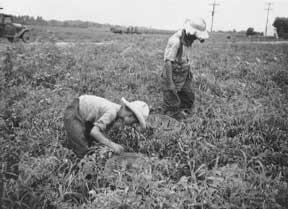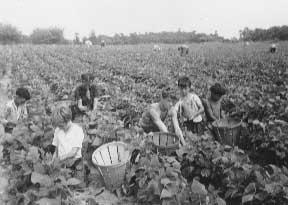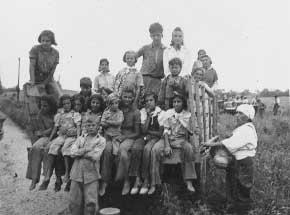In 1924, the Congress submitted to the states for ratification an amendment to the U.S. Constitution that would enable the Congress to regulate child labor. Despite support from Republican president Calvin Coolidge (1923-1928) and Herbert Hoover (1929-1932), by the beginning of the New Deal (1932) the amendment had not achieved ratification by the necessary three-fourths of the states.
Despite the slow process of garnering support for the national child labor amendment, individual states continued to refine their child labor laws in response to problems faced by children. In New Jersey, four problems were identified that led non-government organizations to agitate for reform of the state's child labor laws.
- no regulation of agricultural child workers, particularly those who migrated periodically to different workplaces
- workplace hazards and protecting children from participation in dangerous or high risk occupations
- participation by children in street work, which fell outside the scope of the state's existing labor regulation (examples included peddlers, newspaper vendors and carriers)
- the minimum age for employment, which was 14 provided 8th grade had been completed or 15 after the 6th grade or training for one grade beyond the 5th grade; this was a lower minimum age than in some states and higher than in some others.
The 1930's saw continuing efforts to ratify the 1924 federal child labor amendment, while other measures were proposed at both the federal and state levels to address the problems noted above, particularly as the effects of the Great Depression spread nationwide.
Task
Read the following scenario. Then use the sources provided here, as well as others in this module in THE PROBLEM section, to complete your report to the Governor of New Jersey concerning child labor.
Scenario
It is 1939. The problems facing children during the 7th year of FDR's New Deal remain significant, and no more so than in the area of child labor. You have been commissioned by the Governor of New Jersey to prepare a 500 word essay about the problems facing child workers and how the state of New Jersey could address them - possibly through legislation or other means.
In your 500 word essay, you should:
- Describe the problems facing child workers
- Discuss pros/cons of the impact of the Federal Fair Labor Standards Act (passed in 1938) on child labor in New Jersey and
- Propose solutions for at least two of the four problems noted here: migrant workers, workplace hazards, street workers and the minimum age for employment.
Be certain to consider all sides of the issue as you write. The Governor relies on your expert advice and looks forward to receiving your recommendations.
Documents and Photographs
- Consumers League of New Jersey, Pamphlet on Child Labor Legislation, 1929-1930, Shall Children Be Exploited in New Jersey?
- Letter from Vocational School Director Regarding Child Labor Legislation
- US Department of Labor, Monthly Law Review, June 1931, Child Labor Recommendations of White House Conference on Child Health and Protection
- Exchange of Letters on Child Labor, October 1931
- Recommendations by Conference Committee, Regarding Child Labor Provisions of White House Conference, 1931
- Untitled Commentary on Federal Child Labor Amendment Ratification, May 1933
- Article from New York Times, 1934 "Blow to Home Seen in Child Labor Law"
- Letter and Broadcast Transcript, National Child Labor Committee, April 25, 1935
- National Child Labor Committee, Press Release January 1936
- National Child Labor Committee Incorporated by Act of Congress February 21, 1907 to promote the interests of Children
- Pamphlet, US Department of Labor, 1937 - Child Labor
- Children's Bureau, US Dept. of Labor, 1938, Fair Labor Standards for Children
- A Comparison of New Jersey Child Labor Laws with the Federal Wage and Hour Bill, December 1938
- Photographs of Child Laborers in New Jersey Agriculture - Between 1920 - 1940




